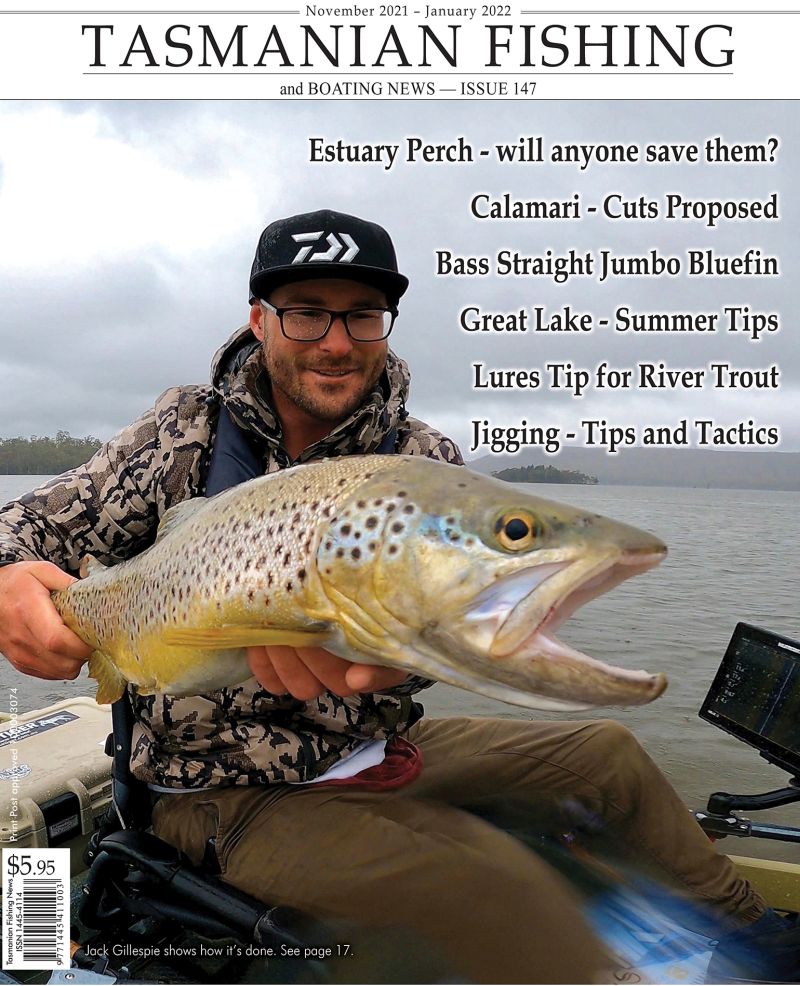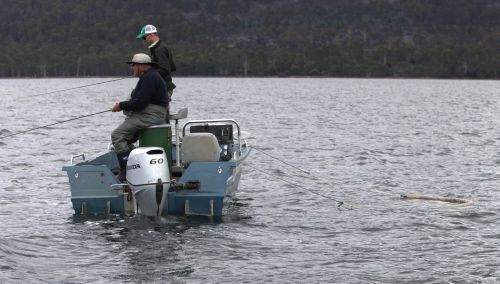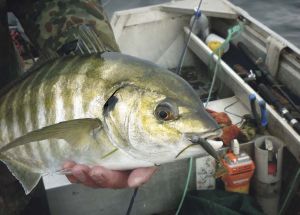 Presented from Issue 110, June 2014
Presented from Issue 110, June 2014
With the arrival of winter, the trout season has, once again, come to an end in Tasmania. If you are still keen to chase trout, there are still a few options. Some inland waters, such as the Great Lake, remain open and, when the weather is good, can provide wintertime fun. Many anglers will take advantage of this, but just as many won’t! It is the time of year when trout spawn and, to a lot of anglers, catching these fish is less challenging – the fish are more likely to be in poor condition and therefore do not put up as much of a fight.
If winter freshwater fishing is not your thing, and you are looking for a challenge, then saltwater estuaries are a fabulous option. Georges Bay at St Helens is probably my favourite estuary for this time of the year. Huge Australian salmon come into the bay and provide fantastic sport on light gear. There is also those tasty garfish! Some people refer to them as ‘mini-marlin’ due to the fact that they like to put up a considerable fight, despite their small size. They are also very tasty!
Although these two fish are good options, I have found the silver trevally gives these two a very good run for their money. Put plain and simple, these fish go hard. They are great fighters and are a fantastic sport fish option. From the moment that you hook up to one of these silver bullets, you can expect your line to be peeling off the reel at blistering speeds! When these fish get close to the surface, they also like to put on a bit of a display, turning on their sides and swimming in circles. They really are a fish that likes to fight to the very end, so be prepared!
There are many effective fishing methods that can be used to take these fish. Hard-bodied lures work very well, as does fresh bait used in conjunction with a bit of berley. When using berley to attract garfish, I will almost always catch trevally as well. In saying that, I prefer to use soft plastics when I am targeting silver trevally. Plastics can be fished shallow or deep, and rigged using many methods. Best of all, they are a cheaper alternative to losing a $25 hard body lure to the brutes in Georges Bay!
Where to find silver trevally?
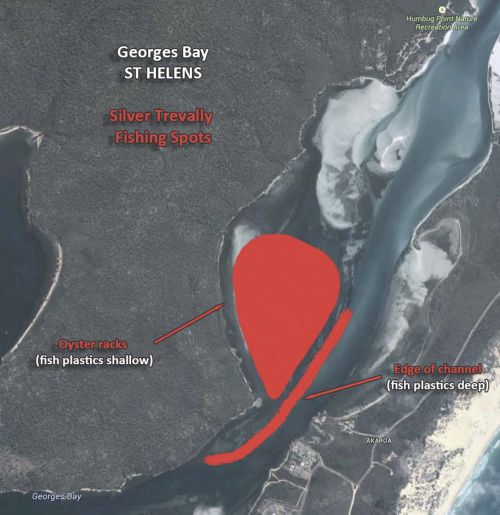
Rock walls
Rock walls can be real hot spots. One such area can be found directly opposite the Steiglitz boat ramp. The big boulders that form the wall along this shore make for fantastic underwater habitats for many fish, including silver trevally. The tidal flow is also a significant factor in making this a great spot to target. Baitfish will often be carried along the length of the wall by the tidal current, giving silver trevally easy access to an abundant supply of food. Just keep in mind that, although these fish can easily handle the strong currents, holding your location can sometimes be a challenge.
To be successful, you need to target the right areas of the wall, and do so at the right times. I have found that the best time to fish for silver trevally is on the run-out tide, and the best area is at the base of the rock wall. Aim to get your plastic right down and hard up against the spot where the rocks meet the sand. This is where they often are, waiting for the passing prey.
Another option is to target the areas at the end of the rock wall that may have swirling areas of water. These are commonly referred to as a ‘back-eddy’.
The baitfish tend to be more concentrated in these areas due to the flow of water and therefore are good spots to find fish.
A third option is to target the same area during the slack tide, which is when the tide is turning. One of the obvious advantages of fishing at this time is that it will be much easier to hold your position in your boat or kayak. It will also be easier to get a plastic down to the bottom due to the fact there is no tidal current.
Channel edges
The channel in Georges Bay also holds good numbers of silver trevally, and big ones at that! In my experience, the fish will hold in the current flow on the channel edges and also around the pylon markers located there. The area where the shallow water drops off into much deeper water that makes up the channel is much like a highway for fish. You don’t need a sounder to find it, just look for the channel markers. You see a clear difference in the water’s appearance. There is normally an obvious line between the light and dark coloured water, with the dark part being the drop-off.
Again, food is the reason for trevally holding in this area. On the outgoing tide, the water retreating off the shallower flats brings a lot of food over the channel edge. For this reason, the outgoing tide is my preferred time for targeting silver trevally in this area. The very start of the incoming tide can also sometimes be good to fish.
Oyster racks
Any type of structure will attract silver trevally, and many other species for that matter. The oyster leases at Akaroa in St Helens would have to be my favourite structures. Casting plastics close in to these can be very effective, but it is a dangerous tactic, with the racks claiming many lures! Ask any bream tournament angler and I am sure that they could share many a sad story!
The water surrounding the oyster leases is usually very shallow and weedy and, because of this, I have found the incoming tide to be of benefit when fishing this area. You can catch some very nice trevally in areas where the weed opens up to a sandy or broken bottom, and areas that certainly should not be overlooked.
Something to consider
While most oyster farmers are tolerant of anglers, please respect their property by not damaging it. Retrieve your lure and jigs. Minimise your boat’s prop wash or use an electric motor if you have one. Even better, get in there with your kayak! Kayaks are stealthy and will work to your advantage in such locations. Be careful not to run over anything and you should do just fine. Remember, a little bit of care and common sense will go a long way for all of us in the future.
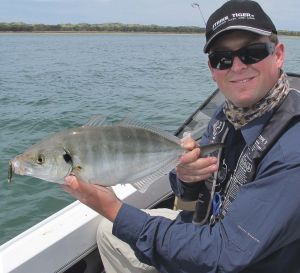 Which soft plastics and how to fish them?
Which soft plastics and how to fish them?
My favourite soft plastics to use are the local Tasmanian brand Strike Tiger 3 inch curl tail grubs and 4 inch worms. Natural looking colours in this range, such as the ‘olive pepper’ colour, work very well, as do the ‘blue steel’ and ‘whitebait pearl’. I use a jighead minimum weight of 1/12 with a hook gape of 1/0 to rig up these lures. I go up to a 1/8 weight when it is windy or if the current is strong. I use a good rod length of fine diameter 8 lb fluorocarbon leader to fish these plastics. I beef up the leader a little due to the fighting skills of this species, and it also gives better abrasion resistance if your line comes into contact with sharp rocks or oysters.
Both the curl tail grubs and worms will swim naturally to the bottom as soon as you cast. I have found that the natural tail action of these lures is very attractive to silver trevally. It is therefore important to anticipate any takes as your lure sinks. Watching for any movement in your line will help you. Also make sure that there is not too much slack in your line – it will help you to keep in touch with your plastic.
Once your plastic hits the bottom, you can start off by just ‘slow-rolling’ (winding it in very slowly without pause) it to the surface. There is nothing special about this technique and it is very easy to master. As you might imagine, soft plastics with plenty of action are well suited to this technique.
The popular ‘lift and drop’ also works very well and is easy to get the hang of. To use this method, simply let the plastic sink – just like in the technique described previously. Once it hits the bottom, simply lift your rod-tip to swim the plastic up off the bottom. As you lower the rod-tip, wind in the slack line slowly, and then repeat.
Stick baits will also work, but a little bit more user input is required in order to give them the desired action. Local brand YEP make some good stick baits in the 3 inch size. Colours that work well on silver trevally in this range include ‘Salt n Peppa’, ‘Pearl White’ and ‘Whitebait’. You can use the same techniques that I have described to fish these, but be sure to throw in a few twitches as the lure sinks and also when it is retrieved. This will give it more of a life-like appearance.
Whichever brand you choose; don’t forget to experiment with your soft plastics. You will find that most can be cut down in size, or possibly modified to alter their appearance. I also like to modify the appearance of the jig head to suit the plastic. A simple coat of nail polish in a colour that matches your plastic and some stick on lure eyes can do wonders. By doing this, your soft plastic will look more realistic.
Conclusion
When I first started hunting for these fish at Georges Bay a few years ago, I had very little idea as to where to start. A lot of my trips with my fishing buddy Ando were purely trial and error. After getting a few tips from some of the locals, I soon discovered that the tide is the single most important influence on fishing in the bay. The hard part was then trying to figure out where the fish might be! By targeting features in the bay such as the channel edges, rock walls and oyster racks – I can definitely say that my success rate improved dramatically. I also feel that using natural looking soft plastic colours and fishing them deep and slow has been a big part of my success. Hopefully this article may have inspired a few of you to take the opportunity to visit the bay and try your luck with soft plastics. Once you have hooked onto that first silver bullet, I guarantee you won’t want to stop!
Final Tips
- Target rock walls - fish your plastics deep and as close to the base of the wall as you can.
- Target the channel edges – fish plastics deep on the drop offs.
- Target the oyster racks – fish close to the structure, also look for areas of clear/broken ground amongst the weed.
- Fish the outgoing tide and also try the very start of the incoming tide.
- Use natural coloured soft plastics.
- Fish your plastics deep and slow.
- Use a lightweight, but fairly stiff spinning rod – a trout outfit is perfect.
- Use a good quality fluorocarbon leader that is matched to braided main line of equal breaking strength - 6lb to 8lb fluorocarbon leader is good.
- Don’t be afraid to experiment with the presentation of your soft plastics – colour and eyes can easily be added to your jigheads to help with this.
- If you are fishing for garfish and using berley – try casting a soft plastic into the berley trail. Silver trevally can often be caught this way.
- For local knowledge, head to St Helens Bait and Tackle and talk to Jamie Henderson.
Silver Trevally - As a Table Fish
I have found that the very large silver trevally can have a very strong ‘fishy’ taste. The best thing to do with them is to take a quick photo and release them. The smaller to medium sized specimens certainly seem to be better eating for me.
Dispatch them quickly and bleed them as soon as possible. The next step is to quickly stick them into an ice-slurry. To cook, coat them in a little seasoned flour and pan-fry them in butter - they will taste fantastic. Trevally is best if eaten fresh (within 2 days) and, in my option, prepared simply.
Silver Trevally - Smoked & Peppered
Try this:
- 6 litres of cold water
- 2 cups of table salt (non-iodised)
- 2 cups of brown sugar
Use only silver trevally fillets for this smoking recipe.
- Submerge them in a brine made of the above ingredients.
- Refrigerate the fillets in the brine for no less than 24 hours.
- Remove fillets and air- dry before smoking.
- Hot-smoke the fillets (skin side down) on low heat for around 4 hours.
- Your smoking time will vary depending on the thickness of your fillets and temperature you choose to smoke at.
- Mesquite or alder chips give trevally a good subtle flavour.
- Once the fillets are smoked, let them cool.
- Place them flesh side up on a chopping board and coat with a good even sprinkle of coarsely crushed peppercorn mix. I use ‘HOYTS’ brand 4 colour peppercorn mix (available at most supermarkets).
- The peppercorns are the perfect finishing touch to smoked silver trevally fillets.
Enjoy with some biscuits and cheese
Mic Rybka


